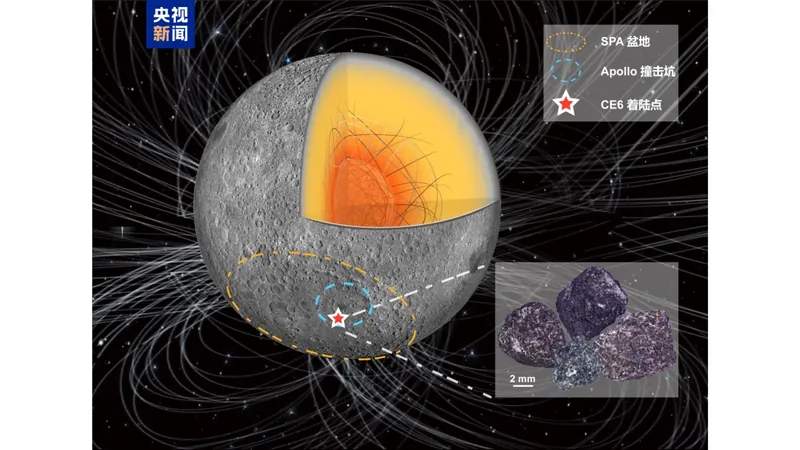
Chang'e-6 Unveils Surprising Revival of Moon's Magnetic Field: What It Means for Lunar Science!
2024-12-22
Author: Olivia
Groundbreaking Revelations from Chang'e-6
In a groundbreaking revelation, rock samples collected from the moon's far side by China's Chang'e-6 lunar probe have provided astonishing insights into the ancient evolution of the moon's magnetic field. The findings, published in the prestigious journal Nature, indicate that the moon experienced an unexpected surge in magnetic field strength 2.8 billion years ago, after a significant drop around 3.1 billion years ago. This discovery challenges long-held scientific beliefs that suggested the lunar dynamo—a process that generates a planet’s magnetic field—remained in a low-energy state following its earlier decline.
Historic Milestone in Lunar Science
This research marks a historic milestone, as it features the first-ever paleomagnetic data gleaned from the moon's far side, illuminating previously obscure stages of the lunar dynamo's lifecycle. The Chang'e-6 mission returned to Earth on June 25 with nearly 1,935 grams of pristine samples from this uncharted lunar territory.
Analysis by the Institute of Geology and Geophysics
A team from the Institute of Geology and Geophysics (IGG) under the Chinese Academy of Sciences meticulously analyzed four basalt fragments from these samples. They uncovered a significant increase in the paleomagnetic field strength, hinting at a possible reawakening of the lunar dynamo long after it was believed to have weakened. The researchers speculate that this resurgence might stem from shifts in energy sources fueling the dynamo or a revival of the geological forces that originally powered it.
Current State of the Moon's Magnetic Field
Satellite and surface data show that the moon currently lacks a global dipole magnetic field. However, lunar samples discovered earlier suggested that the moon's magnetic field was once comparable to Earth's, particularly between 4.2 and 3.5 billion years ago, before it underwent two major declines, ultimately fading away over a billion years ago.
Lingering Questions and Future Exploration
Yet, key questions linger about the exact timeline, duration, and mechanisms that governed these changes in the moon's magnetic field, revealing significant gaps in our understanding of the moon's far side.
Insights from Chinese Scientists
Cai Shuhui from the IGG remarked, “Understanding the evolution of the lunar dynamo is crucial for revealing the moon's internal structure, thermal history, and surface environment.” This new analysis fills a staggering billion-year gap in the lunar paleomagnetic record and represents a monumental advancement in our comprehension of lunar magnetism.
Alignment with Other Findings
Furthermore, the findings align with other significant discoveries from the Chang'e-6 mission. In November, researchers reported two volcanic events occurring on the moon's far side, dated at 2.8 billion and 4.2 billion years ago. Another study published in Science corroborated these findings, confirming that the low-titanium samples collected are approximately 2.83 billion years old, providing yet more evidence of volcanic activity on the moon's mysterious far side.
Conclusion: The Future of Lunar Exploration
With each new finding, the allure of lunar exploration deepens, challenging scientists to rethink established models and further unravel the moon's enigmatic past. What else might lie beneath the surface, waiting to be discovered? Stay tuned!









 Brasil (PT)
Brasil (PT)
 Canada (EN)
Canada (EN)
 Chile (ES)
Chile (ES)
 España (ES)
España (ES)
 France (FR)
France (FR)
 Hong Kong (EN)
Hong Kong (EN)
 Italia (IT)
Italia (IT)
 日本 (JA)
日本 (JA)
 Magyarország (HU)
Magyarország (HU)
 Norge (NO)
Norge (NO)
 Polska (PL)
Polska (PL)
 Schweiz (DE)
Schweiz (DE)
 Singapore (EN)
Singapore (EN)
 Sverige (SV)
Sverige (SV)
 Suomi (FI)
Suomi (FI)
 Türkiye (TR)
Türkiye (TR)